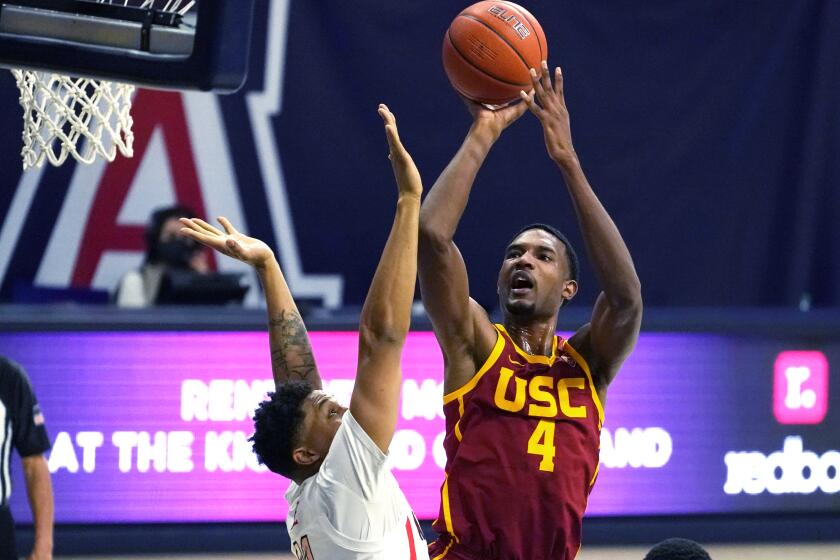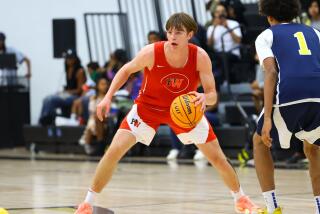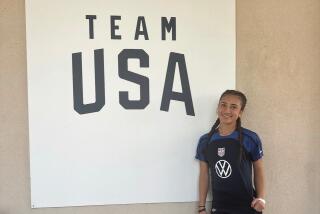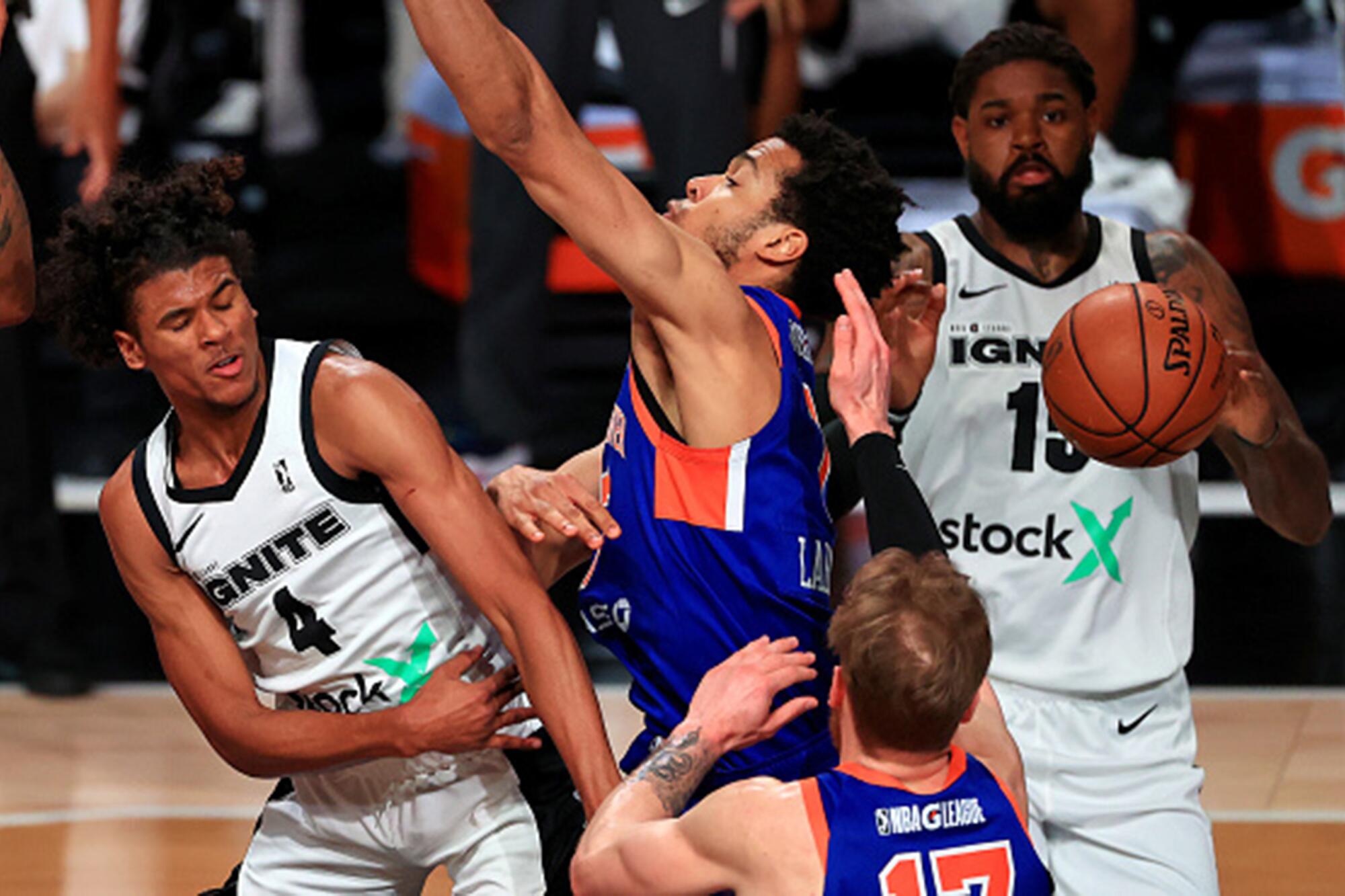
- Share via
Days before his 19th birthday, Kevin Garnett stood inside a Springfield, Mass., hotel in front of teammates at Nike’s Hoop Summit, featuring some of the best high school basketball players in the country, explaining why he was bucking convention by not following them to college.
One of Garnett’s peers, a Georgia forward bound for California named Shareef Abdur-Rahim, heard the reasoning that day but struggled to process the apparent risk. No one in 20 years had gone directly from high school to the NBA.
“He’s crazy,” Abdur-Rahim recently recalled thinking. “Like, he’s out of his mind.”
Garnett’s decision, of course, wasn’t doomed but a trend-setting moment. His immediate success as an NBA rookie, the start of his Hall of Fame career, opened a preps-to-pros pipeline that lasted a decade until the NBA ruled in 2006 that draft-eligible prospects must be at least one year out of high school.
The moment in the hotel and what it foretold has been instructive in recent years for Abdur-Rahim, now the president of the NBA’s developmental arm, the G League. Because 26 years later, the NBA draft on Thursday is notable not only for its entrants’ potential but the differing pathways that led them there.
For the first time, the draft’s 60 selections will include not only prospects trained in college or internationally but through G League Ignite, a special team created by the NBA last year to pay and nurture recruits who otherwise would have been bound for college.
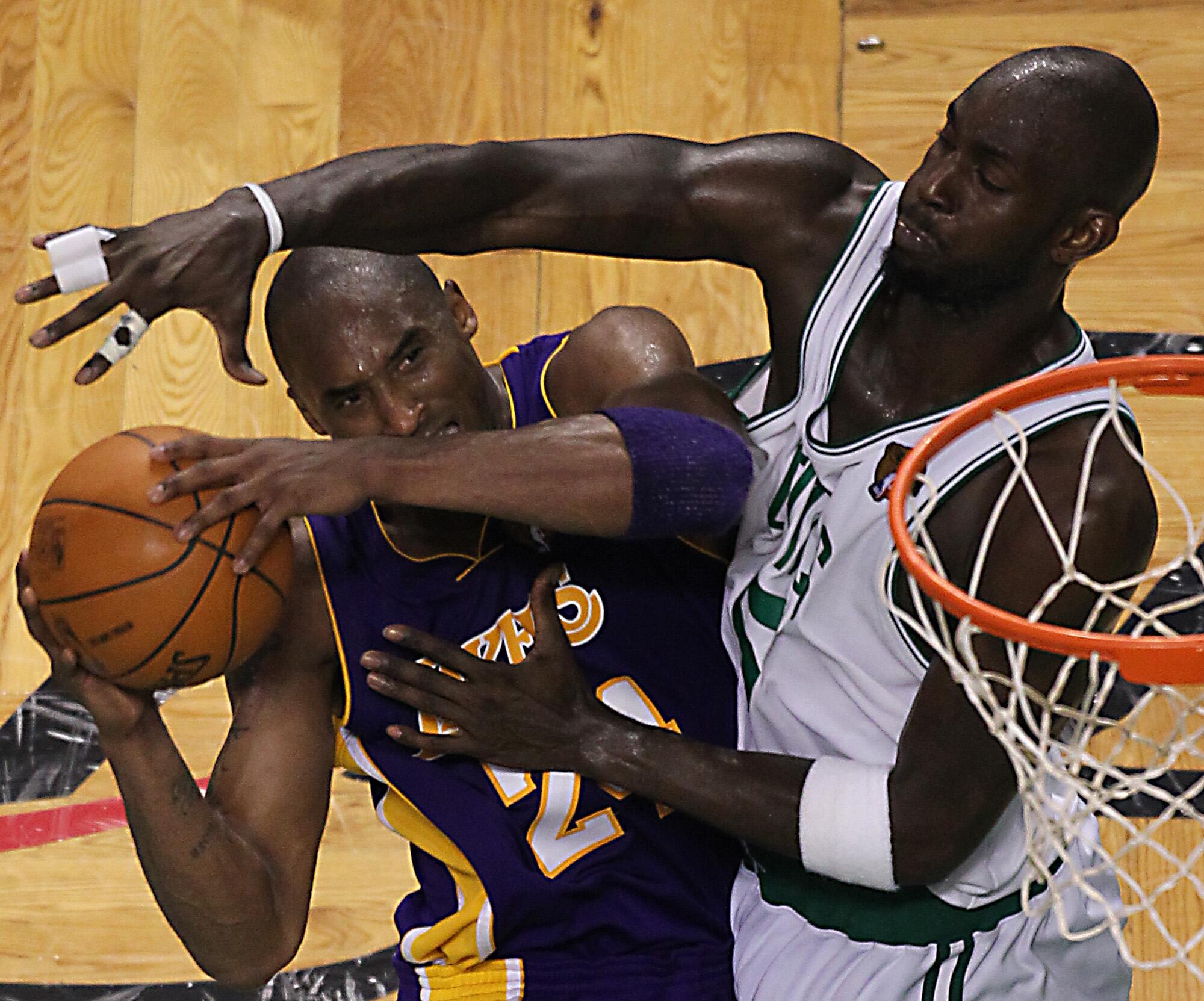
Just as Garnett’s example changed the perception of a teenager’s readiness to compete in the NBA, the backers of and participants in nascent developmental leagues including Ignite and Overtime Elite believe they could do the same for Gen Z — and signal the start of a significant shift in the way the world’s elite basketball talent prepares for the NBA game.
“I think these kids, they’re exposed at a younger age to the NBA and NBA players and in closer proximity to them,” Abdur-Rahim said. “Their belief in themselves is totally different. They’re just empowered and I think that’s where this comes from.”
Mock drafts project Ignite teammates Jalen Green, a 19-year-old, 6-6 guard from Fresno, and Jonathan Kuminga, a 6-7 forward from the Democratic Republic of Congo, as top-10 picks, with Daishen Nix, who was UCLA’s top 2020 recruit before decommitting, and Isaiah Todd expected to be picked in the second round after spending the last year on contracts that paid up to $500,000.
They will be the first data points of whether sweeping change is coming within the basketball development industrial complex.
In September, the sports media company Overtime will begin the first season of its Overtime Elite league, which calls for its roster of between 24 and 30 athletes — some of whom are as young as 16 and have signed contracts reportedly worth seven figures — to play against one another as well as prep schools in the U.S. and internationally. Salaries begin at $100,000.
“For players like us who want to make it to the NBA, this is the best program to maximize our development,” wrote Matt and Ryan Bewley, a pair of Florida teens once ranked among the top 20 of the class of 2023, by email sent through an Overtime representative. “And being the first ones to sign, sort of pioneers, was really cool.”
The eight-city Professional Collegiate League also is set to debut soon. Its athletes will play by NBA rules, draw salaries between $50,000 and $150,000, and can sign individual endorsement contracts while also receiving a five-year academic scholarship.
Based in Atlanta, Overtime’s athletes will go to school and train inside a complex featuring two NBA-regulation-sized practice courts and a “show court” with seating for 1,600 fans.
How much Ignite, Overtime Elite and the PCL might disrupt the NCAA model, now that college athletes can be paid for the use of their name, image and likeness, has been debated and examined. Scouts and executives who have crisscrossed Europe more than Rick Steves looking for prospects, and traveled as far as Australia and New Zealand to watch Chino Hills guard LaMelo Ball’s brief stop in the National Basketball League, say the more relevant question is whether they can consistently develop pro-caliber players.
In what order will Cade Cunningham, Jalen Green and Evan Mobley be selected at the start of the 2021 NBA draft on Thursday? We sort through the options.
“We’ll go where the players are,” one team executive said. “If the idea is to attract and get eyes, players need to know where we are going, they got to be the right talent level.”
To give their prospects the best chance to reach that level, the G League and Overtime have each designed what they believe to be the new style of basketball incubator.
“That proximity to the NBA and to our teams, that gives us some credibility, that gives us some know-how, that gives us some legitimacy in this, for sure,” Abdur-Rahim said.
In February, while their NCAA peers had been on television for four months, Ignite’s players were still training and living in Walnut Creek, Calif., in relative obscurity as they prepared for the G League’s COVID-abbreviated monthlong “bubble” to open in Florida. Meals prepared by a chef were dropped off three times daily to upscale condominiums where the teens lived alongside NBA veterans including Jarrett Jack, a 37-year-old guard who played 13 NBA seasons. Sprinter vans ferried them around town.
Ignite last season was coached by longtime NBA coach Brian Shaw, whose departure to become a Clippers assistant this month has led to the reported hiring of USC assistant coach Jason Hart.
One scout who observed Ignite’s first season called the adjustment a “huge jump” as they learned spacing and the speed of professional competition but considered the year helpful for most who took part.
Seeing Green slow to attack a zone defense in one game, Jack told Green that a zone required a point guard to be more decisive. A few possessions later, Green did it the right way and flashed Jack a thumbs up.
“I don’t think they got lost,” the scout said. “I just wish they played a little bit more. You can see them against grown men.”
Jack viewed his most important role as helping keep his teen teammates from “bumping their head” upon their arrival in the pros. He, along with other veterans including Amir Johnson, discussed how to practice with purpose, manage expectations from family members after earning life-changing money to how to relax outside of the public eye.
Said Kuminga: “Being around those veterans is just an advantage compared to a guy going to college.”
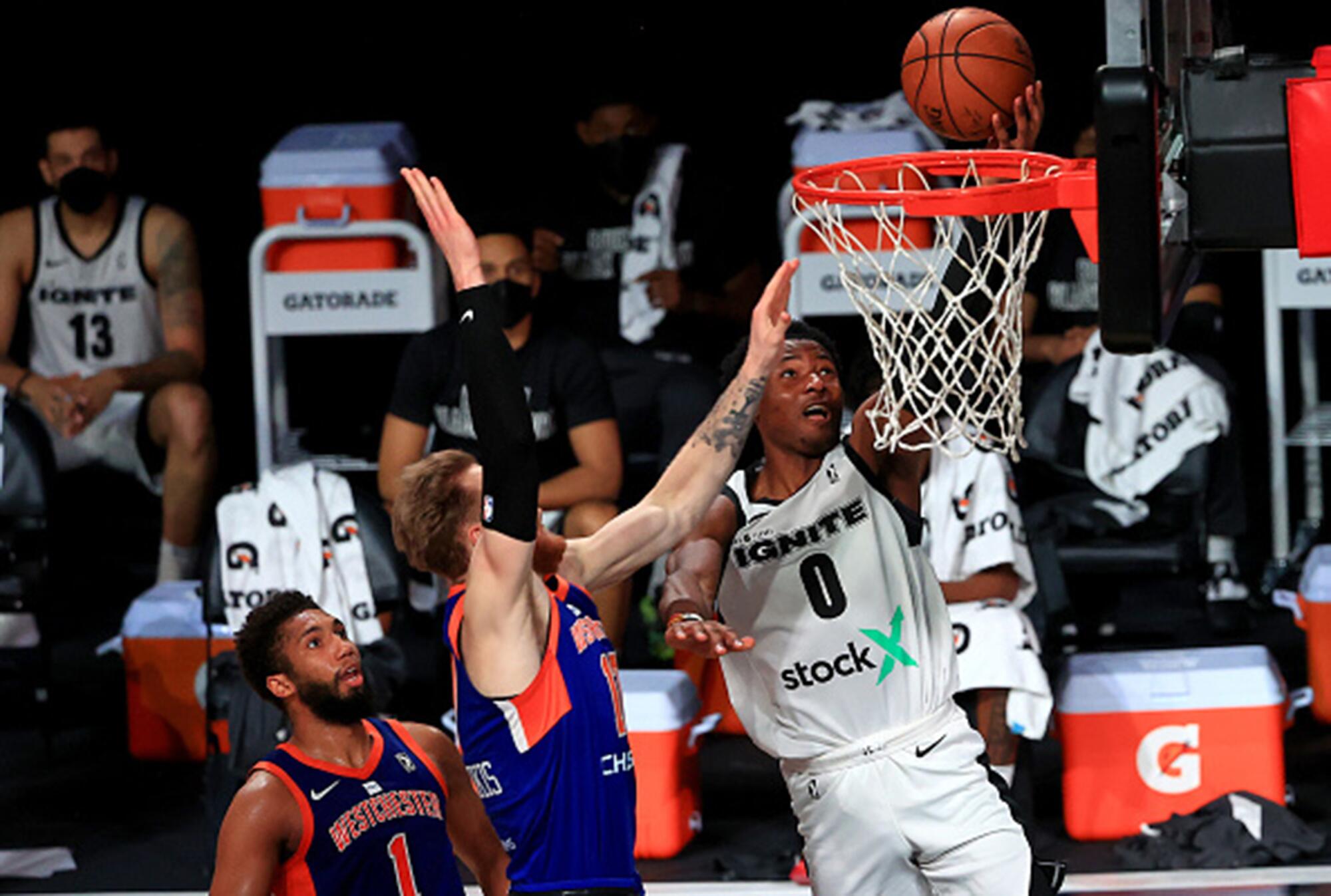
For being an “odd year” because of COVID-related limitations, Abdur-Rahim said he considered the first season productive but acknowledged perhaps overwhelming the teens by trying to give them “every experience, all the information.” Its roster of teen commits has stayed small while the G League tests how to ensure each has enough opportunities in practice and games, he said.
Overtime Elite commissioner and president Aaron Ryan, who worked in the NBA’s league office for 22 years, drew on experience working with USA Basketball when it came to designing a support system to surround elite talent — nutritionists, coaching and technology used by NBA teams. There is an academic component as well.
He noted that Brandon Williams, a former team executive in the NBA who acts as Overtime Elite’s head of basketball operations, knows what scouts and executives want to see. Kevin Ollie, who coached Connecticut to an NCAA title, leads Overtime Elite’s coaching staff.
One agent who described himself as initially skeptical of Ignite said he had changed his mind and believes it and other domestic leagues paying athletes would “always have a market” of interested players ready to skip college, even as universities have begun allowing athletes to earn money from NIL use, and even if the NBA rescinds its “one-and-done” rule for draft eligibility.
The Bewley brothers wrote that the prospect of “changing the game, that was a driving factor for us” in their decision and added that though they were now being paid, “the focus doesn’t change.”
Ignite has four players confirmed on next season’s roster: Dyson Daniels, a 6-4 Australian guard and alumnus of the NBA’s Global Academy, and three of the top-20 recruits from the class of 2021: 6-9 forward Michael Foster Jr., 6-4 guard Jaden Hardy and 6-3 guard Scoot Henderson.
Jack welcomed with caution the rise of domestic options for players who didn’t want to bypass the NCAA by playing abroad.
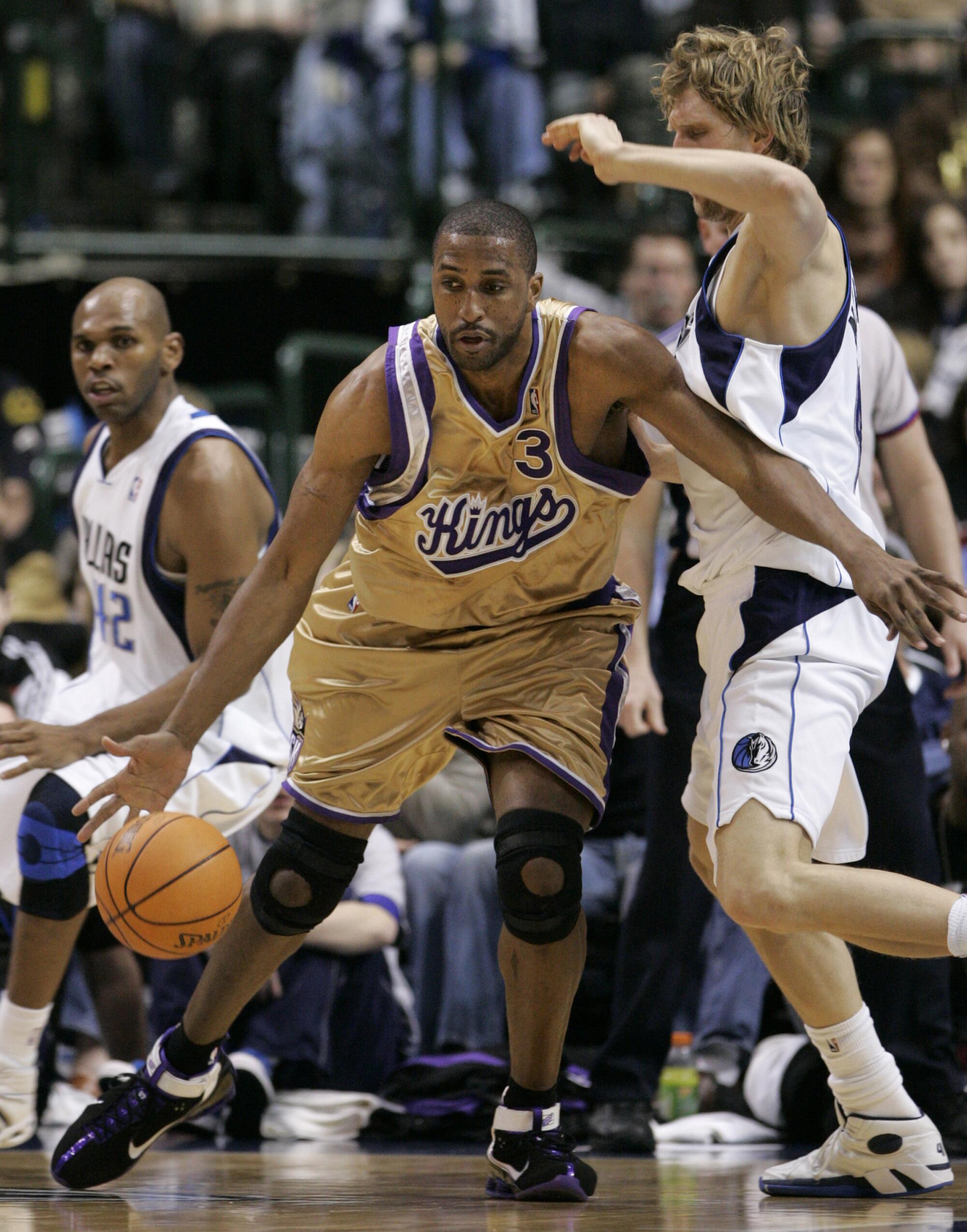
“These leagues who are saying, we can be a fast-forward process, and who compensate you, I think they’re great, but I also don’t believe that they’re for everybody,” Jack said. “There are some guys that are going to jump right into this thing and they’re going to play right away and there are going to be some guys who may never, ever play in the NBA, meaningful minutes.”
Stakeholders within the NBA, which foots the bill of Ignite, viewed the first season’s trial run enthusiastically, Abdur-Rahim said. Its future could hinge on whether team owners believe its track record of consistently producing difference-making professionals is worthy of the costs of research and development.
Overtime, which raised $80 million in funding this year from investors, including Jeff Bezos, would gain credibility within NBA circles by producing future household names too, of course. But Ryan described a business model that aims to capture and grow its more than 50 million followers by creating programming that takes viewers “alongside people who are on extraordinary paths,” in essence establishing a connection between audience and athlete years before they become established stars.
Amid so much uncertainty surrounding the upstart leagues, one thing is already certain: No one looks at recruits considering such paths to the NBA as crazy anymore.
Last week, Emoni Bates, a 6-8 forward rated second overall in the class of 2022 by 247Sports’ composite rankings, announced he had winnowed his list to five colleges, the National Basketball League — and Overtime Elite and G League Ignite.
“I paint the picture all the time for our staff,” Ryan said. “What we hope to see happen in short order is an OTE athlete take that stage in Brooklyn or New York or wherever the NBA takes the next draft, to shake the commissioner’s hand, put on that hat of whatever lucky team receives them and to flash that ‘O’ into the camera and to make us all proud down here in Atlanta.”
More to Read
Go beyond the scoreboard
Get the latest on L.A.'s teams in the daily Sports Report newsletter.
You may occasionally receive promotional content from the Los Angeles Times.

